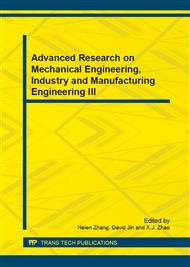p.145
p.150
p.154
p.163
p.167
p.172
p.176
p.180
p.184
Molecular Dynamics Simulations of Sliding Friction of Rigid Sphere with Single Crystal Copper Surface
Abstract:
Using LAMMPS to establish the three-dimensional sliding friction model of the nanoscale diamond hemisphere with the single-crystal copper surface. Simulation and solving the process of sliding friction, research the micro-contact area atomic states change in sliding friction process, and study the friction characteristics change when the rigid sphere sliding on rough surface of the single crystal copper with minute projections. The results indicate that, in the sliding friction process, the lattice of substrate atoms are damaged under the forces of the extrusion which also cause corresponding dislocation and deformation. In the direction of the hemisphere movement, generate the pileup and side stream phenomena, and produce furrows. Friction and normal force rapidly increase with the depth of contact, and then enter into a stable sliding phase. For the thermal motion of atoms, formation of dislocations and the stick-slip effect, the curves of friction and normal force present waves of sawtooth. Small defect on surface of the substrate almost have no effect on the process of sliding friction.
Info:
Periodical:
Pages:
167-171
Citation:
Online since:
August 2013
Authors:
Keywords:
Price:
Сopyright:
© 2013 Trans Tech Publications Ltd. All Rights Reserved
Share:
Citation:


